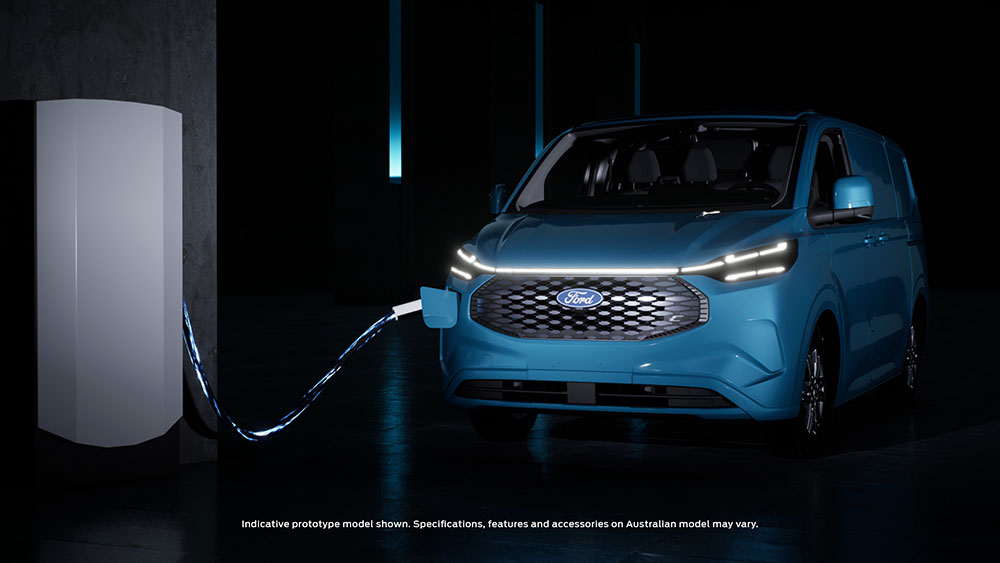Electric vans on the charge
The commercial vehicle segment has an important role to play in decarbonising Australia’s transport options, with three new all-electric models from Ford and Mercedes-Benz indicating the change is underway.

Mercedes-Benz is set to become the first prestige carmaker to introduce an electric van and a people mover to the Australian market, following confirmation the company had opened the order books for both its battery electric eVito Panel Van and eight-seat eVito Tourer.
Ford Australia has also confirmed the arrival of its own battery electric E-Transit Custom model, although the Blue Oval eco-van is not due here until late 2024.
There’s no such issue with the twin electrically powered Mercedes-Benz models, with company spokesperson Blake Vincent saying both vehicles were available to order now from the company’s Spanish factory, with deliveries expected to take about six months.
He said Mercedes-Benz Australia also had limited stock available now in both variants and is expecting more vehicles between now and the end of the year.
The new models will swell the ranks of the available battery electric commercial van offerings in Australia, something that’s seen as an important step in the decarbonising of Australia’s transport sector, which makes up an estimated 19% of total CO2 emissions.
Other brands with electric vans already on the market include the Australian-made Ace Cargo Light and Yewt, the Chinese BYD T3, EV Automotive’s EC11, SEA Electric’s EV4, and Renault’s compact Kangoo Maxi.
Costing $89,353 (MRLP), the eVito Panel Van combines a 60kW/h battery pack with an electric motor, sending 85kW/360Nm to the front wheels via a single-speed transmission.
Energy consumption is estimated at 27.36 kW/h per 100km, equating to an estimated driving range of up to 262km (NEDC) between recharges.
Mercedes-Benz said this made the eVito Panel Van ideal for inner-urban delivery loops with 100% of its torque available from a standing start, ensuring smooth acceleration and excellent tractability in stop-start urban traffic.
With 882kg of payload and a GVM of 3,200kg, the eVito Panel Van can accommodate a variety of cargo types with up to 6 cubic metres of cargo load volume and dual rear sliding doors for easy access.

Mercedes-Benz eVitor Panel Van.
Charging time using the vehicle’s inbuilt Type 2 (CCS) charging system takes about 6.5 hours from 0 to 100% if using an 11kW AC charger; while an 80kW DC fast charger can top up the battery from 10 to 80% in just 35 minutes.
The Mercedes-Benz eVito Tourer, meanwhile, is set to become the first all-electric eight-seat people mover to enter the Australian passenger and commercial vehicle market.
Formerly known as the Valente, the eVito Tourer is priced at $116,115 (MRLP) and offers seating for eight.
It’s expected to be sought-after by businesses including airport transfer companies and local councils, according to Mercedes-Benz.
Sharing the same underpinnings and architecture as the eVito Panel Van, the eVito Tourer includes seating for eight in a 2:3:3 configuration with the seats able to be individually folded down to increase cargo space.
Large side windows and 17-inch alloy wheels are the key externally differentiators but under its skin the eVito Tourer is equipped with a more powerful electric motor sending 150kW/365Nm to the front wheels.
Its larger 90kW/h usable battery capacity and lower 26.15 kW/h per 100km power consumption gives an indicative touring range of up to 421km (NEDC).
Charging the eVito Tourer’s battery from 0 to 100% using 11kW AC charging takes about 10 hours, while 110kW DC fast charging takes about 45 minutes from 10 to 80%.
Both models require servicing only every 12 months or 40,000km (whichever occurs first) and are covered by 24-hour roadside assistance, plus a five-year or 250,000km warranty on the vehicle and eight-year or 160,000km battery warranty.
Mr Vincent said Mercedes-Benz had not yet confirmed any major fleet customers for either model, despite major brands like Australia Post committing to decarbonising their fleets.

Mercedes-Benz EVito Tourer.
“There’s a lot of interest with large fleet customers and we’re working with them, taking them through the products, but there are no large orders to announce yet,” he said.
Ford Australia, meanwhile, will likely be watching the early arrival of the Mercedes-Benz electric twins with envy, given that it faces a wait until the end of 2024 before its E-Transit Custom arrives here.
Featuring a range of technologies designed to maximise its effective range, the E-Transit Custom boasts a flat floor to reduce drag, wind-cheating wheel designs, and even rear light cluster shapes that have been developed using more than 800 different aerodynamic simulations, reducing drag by more than 10% compared with the previous-generation Transit Custom.
The long wheelbase panel van boasts a maximum load length of 3,450mm, with load volumes of 6.8 cubic metres or 9.0 cubic metres with the high roof option.
The vehicle features next-generation battery technology that enables a targeted range of 380km and 124kW fast-charging ability, according to Ford.
The 400-volt, 74kWh useable battery pack is mounted direct-to-body for improved durability and reduced weight.
Australian-spec vehicles will offer a 160kW/415Nm electric motor fitted directly to the vehicle’s rear floor, removing the need for a dedicated subframe, and rotated 90 degrees to maximise load space and reduce weight and complexity.
An 11kW AC three-phase onboard charger is capable of fully recharging the battery in 7.2 hours and the vehicle also supports DC fast charging up to 124kW for a 15 to 80% recharge in 41 minutes.
While the news of these three commercial models indicates the pace of electric passenger vehicle adoption is accelerating, electric vans and other commercial vehicles largely remain stuck in the slow lane, with still only a small number of models for buyers to choose from.
Industry advocates say greater model choice, lower purchase price, and more charging options are necessary to encourage more widespread EV adoption.
Related topics
Things to note
The information in this article has been prepared for general information purposes only and is not intended as legal advice or specific advice to any particular person. Any advice contained in the document is general advice, not intended as legal advice or professional advice and does not take into account any person’s particular circumstances. Before acting on anything based on this advice you should consider its appropriateness to you, having regard to your objectives and needs.
Insurance Products (excluding Travel Insurance) are issued by RACQ Insurance Limited ABN 50 009 704 152 (RACQI) and arranged by its agent, RACQ Distribution Services Pty Ltd (RDS) ABN 35 116 361 650, AFSL 567130 and RDS' authorised representatives (including RACQ Operations Pty Ltd ABN 80 009 663 414, AR No. 234978 (RACQO). Conditions, limits and exclusions apply. RDS and RACQO are in the RACQ group of companies. One of the companies in the RACQ group of companies has a minority shareholding in RACQI.
RDS and RACQO have not taken your personal objectives, circumstances or needs into account when preparing advice regarding insurance products and you will need to consider whether the advice is appropriate for you. Read the Product Disclosure Statement (PDS) and any applicable Supplementary PDS before making a purchase decision on this product. You can also access our Target Market Determinations on this website. RDS receives a commission from RACQI for the policies it arranges. RACQO receives fees paid for services it provides to RDS. Further details about remuneration are available on request prior to purchasing.
Banking and loan products issued by Members Banking Group Limited ABN 83 087 651 054 AFSL/Australian credit licence 241195 trading as RACQ Bank. Terms, conditions, fees, charges and lending policies apply. This is general advice only and may not be right for you. This information does not take your personal objectives, circumstances or needs into account. Read the disclosure documents for your selected product or service, including the Financial Services Guide and the Terms and Conditions, and consider if appropriate for you before deciding.
Except for RACQ Bank, any RACQ entity referred to on this page is not an authorised deposit-taking institution for the purposes of the Banking Act 1959 (Cth). That entity’s obligations do not represent deposits or other liabilities of RACQ Bank. RACQ Bank does not guarantee or otherwise provide assurance in respect of the obligations of that entity, unless noted otherwise.
RACQ Bank subscribes to the Customer Owned Banking Code of Practice which establishes higher standards than the law requires. The Code reflects modern consumer expectations and developments in approaches to issues such as consumer vulnerability, guarantors, and supporting customers through financial hardship. Please read our Customer Owned Banking Code of Practice page for more information.
RACQ Operations Pty Ltd (ABN 80 009 663 414 AR 000234978) and Members Travel Group Pty Ltd (ABN 45 144 538 803 AR 000432492) are acting as an Authorised Representative of the issuer of the insurance, Tokio Marine & Nichido Fire Insurance Co., Ltd. (ABN 80 000 438 291 AFSL 246 548). Any advice set out above is general in nature only, and does not take into account your objectives, financial situation or needs. Before purchasing any travel products, please consider the RACQ Travel Insurance Product Disclosure Statement (PDS) and the Target Market Determinations (TMDs) that apply to these products. Whilst the PDS outlines the Terms and Conditions of these products, the TMDs outline the intended class of customers that comprise the target market for these travel products. This will allow you to consider which products best suit your objectives, financial situation and needs and consider the products appropriateness to your personal circumstances. TMDs also outline matters involving the distribution and the review of these products. The PDS, Supplementary PDS and TMDs for each travel product can be found here.

